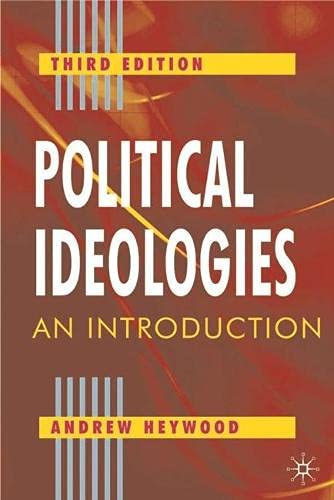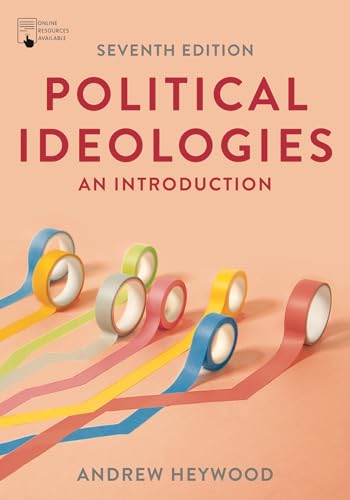As an Amazon Associate, we earn from qualifying purchases. Some links may be affiliate links at no extra cost to you. Although our opinions are based on curated research, we haven't used these products. Articles generated with AI.

The 7 Best Political Ideologies According to Andrew Heywood – An In-Depth Exploration
Andrew Heywood’s exploration of political ideologies highlights seven key movements that shaped our world: liberalism, conservatism, socialism, feminism, ecologism, fascism, and democratic socialism. Each ideology has unique historical roots and impacts on society. For example, liberalism focuses on individual rights, while socialism critiques social inequality. Heywood emphasizes the importance of understanding these ideologies in the context of significant events, like the French Revolution. Discover how these movements influence today’s political landscape and what they mean for the future.
Key Takeaways
- Andrew Heywood’s textbook offers a detailed exploration of ten major political ideologies, including liberalism, conservatism, socialism, and feminism.
- Core themes and historical contexts for each ideology are discussed, aiding reader comprehension of their relevance and evolution.
- Heywood emphasizes the influence of key thinkers, such as John Locke for liberalism and Karl Marx for socialism, shaping ideological interpretations.
- The accessible writing style and structured layout make the material suitable for both beginners and political science students.
- While comprehensive, the book contains minor grammatical errors and variations in chapter development that may affect readability but do not diminish its value.
Political Ideologies: An Introduction
Political Ideologies: An Introduction
- Hardcover Book
- Heywood, Andrew (Author)
- English (Publication Language)
If you’re a student diving into the world of politics, “Best Political Ideologies According to Andrew Heywood” is an excellent choice for understanding the landscape of political thought. This book acts as your guiding light through various ideologies—like liberalism, conservatism, and socialism—while also exploring contemporary movements such as feminism and ecologism.
- Comprehensive Coverage: You’ll learn about historical developments and how each ideology influences social circumstances.
- Clear Explanations: Complex concepts become digestible, especially useful for health policy courses.
Just keep in mind its occasional editing issues as you engage with this foundational text.
Best For: Students and general readers seeking a clear introduction to political ideologies and their historical contexts.
Pros:
- Comprehensive coverage of traditional and contemporary political ideologies.
- Clear and digestible explanations make complex concepts accessible.
- Valuable resource for foundational understanding, especially in courses like health policy.
Cons:
- Contains numerous grammatical errors and typos that detract from readability.
- Later chapters on topics like ecologism and feminism may feel less developed.
- Academic style may be perceived as boring by some readers.
Political Ideologies: An Introduction
Political Ideologies: An Introduction
- Used Book in Good Condition
- Heywood, Andrew (Author)
- English (Publication Language)
Understanding political ideologies is essential for anyone traversing today’s complex political landscape. “Best Political Ideologies According to Andrew Heywood” is particularly suitable for political science students and professors, as it provides a deep yet accessible exploration of various ideologies.
Key Features of the Textbook
- Comprehensive Resource: It covers ten major ideologies including Liberalism, Conservatism, and Socialism.
- Structured Content: Each chapter discusses origins, core themes, and globalization responses.
- Clear Style: Written for beginners, it avoids complex language and offers a visually appealing layout.
While minor typos may distract, it’s highly recommended for enriching your understanding of political ideologies.
Best For: Political science students and professors seeking a comprehensive and accessible resource on political ideologies.
Pros:
- Covers ten major political ideologies with structured content for easy understanding.
- Utilizes clear, accessible language suitable for beginners in political science.
- Provides valuable supplementary resources for deeper exploration of topics.
Cons:
- Contains numerous minor typos that can distract from the reading experience.
- Published in British English, which may be slightly challenging for American students.
- Some editorial standards may be perceived as lacking due to glaring errors.
How Fascism Works: The Politics of Us and Them
Sale
How Fascism Works: The Politics of Us and Them
- Stanley, Jason (Author)
- English (Publication Language)
- 256 Pages - 05/26/2020 (Publication Date) - Random House Publishing Group (Publisher)
- Historical Context: Understanding past fascist movements is essential for grasping today’s political dynamics.
- Current Relevance: The rise of certain tactics within the Republican Party echoes historical examples, prompting serious reflection.
- Practical Impact: The book highlights the warping of minds and hierarchical structures typical in fascist ideologies.
You’ll find it a compelling read—especially relevant for today’s challenges.
Best For: Readers interested in understanding the historical context of fascism and its implications on current political dynamics, particularly those concerned about the rise of authoritarian tactics.
Pros:
- Informative Content: Provides a thorough analysis of fascism and its historical impact, making it essential for informed political discourse.
- Relevant Examples: Draws clear parallels between contemporary political strategies and historical fascist movements, enhancing the reader’s understanding of current events.
- High Physical Quality: The book’s print quality is excellent, making it a visually appealing addition to any collection.
Cons:
- Accessibility Issues: Those who would benefit most from the book may not be inclined to read it, limiting its potential impact on public discourse.
- Perceived Value: Some readers feel the book’s smaller size does not justify its price, leading to mixed feelings about its value.
- Lower Binding Quality: Although the content is strong, the binding and dust jacket quality have received criticism, which may detract from the overall reading experience.
Political Ideologies: An Introduction
Political Ideologies: An Introduction
- Heywood, Andrew (Author)
- English (Publication Language)
- 400 Pages - 02/13/2017 (Publication Date) - Red Globe Press (Publisher)
For students and enthusiasts intrigued by the complexities of political thought, “Best Political Ideologies According to Andrew Heywood” serves as an essential guide. This book is not just a collection of ideas; it’s a structured exploration of various political ideologies.
Key Features:
- Clear Structure: Each major ideology is detailed in its own chapter.
- Key Thinkers: Profiles of influential figures enhance your understanding.
- Definitions: Key terms are conveniently explained in boxes.
Though some may find it redundant, it’s perfect for beginners, combining historical context with accessible writing. Andrew Heywood’s credibility adds further value. Immerse yourself and deepen your political knowledge!
Best For: This book is best for students and beginners interested in understanding political ideologies and their historical context.
Pros:
- Engaging Writing: The accessible style keeps readers interested and facilitates comprehension.
- Comprehensive Overview: Each ideology is covered in detail, providing a solid foundation in political thought.
- Credible Author: Andrew Heywood’s expertise enhances the book’s reliability as an academic resource.
Cons:
- Redundancy for Advanced Readers: Those with prior knowledge may find some content repetitive.
- Not Essential for All Courses: Some may not see its necessity for PSIR optional studies.
- Basic for Experienced Students: Advanced learners might find the content too simplistic or introductory.
Political Ideologies
Political Ideologies
- Baradat, Leon P. (Author)
- English (Publication Language)
- 396 Pages - 09/15/2016 (Publication Date) - Routledge (Publisher)
- Accessible Writing: You’ll find it easy to grasp complicated concepts.
- Diverse Perspectives: Understanding opposing views builds critical thinking.
- Useful Resource: A great rental option for students this semester.
The positive feedback hints that many find it valuable, making it a worthy addition to your reading list.
Best For: Individuals seeking to understand various political ideologies, especially those with little prior knowledge.
Pros:
- Accessible Writing: Complex concepts are explained in a clear and straightforward manner.
- Diverse Perspectives: Engaging with opposing views enhances critical thinking skills.
- Useful Resource: Ideal for students, providing a rental option for timely access.
Cons:
- Possible Bias: Readers may feel influenced by the author’s perspectives.
- Limited Depth: Some readers may seek more in-depth analysis of specific ideologies.
- Target Audience: Not suited for individuals who already have a solid understanding of political ideologies.
Political Ideologies, Fourth Edition: An Introduction
Sale
Political Ideologies, Fourth Edition: An Introduction
- Heywood, Andrew (Author)
- English (Publication Language)
- 432 Pages - 05/15/2007 (Publication Date) - Palgrave Macmillan (Publisher)
- Liberalism
- Conservatism
- Socialism
- Fascism
Each chapter discusses the history, key thinkers, and core principles of these ideologies. Illustrative charts and summary boxes provide visual aids, enhancing understanding. Despite some delivery issues noted by readers, the content remains invaluable for students and self-learners enthusiastic to explore political thought.
Best For: This book is best for students and casual readers seeking a clear and comprehensive understanding of political ideologies without a prior political background.
Pros:
- Provides an accessible introduction to complex political concepts, making it suitable for beginners.
- Includes illustrative aids like charts and summary boxes that enhance comprehension and serve as quick references.
- Covers a wide range of ideologies and their historical contexts, promoting deeper interest and critical engagement in political discussions.
Cons:
- Some readers reported physical condition issues upon delivery, such as torn covers and pages.
- The straightforward writing style may oversimplify certain ideologies for more advanced readers.
- Limited exploration of niche ideologies compared to the breadth of major ones covered.
Political Ideologies: An Introduction
Sale
Political Ideologies: An Introduction
- Heywood, Andrew (Author)
- English (Publication Language)
- 21 Pages - 04/06/2021 (Publication Date) - Bloomsbury Academic (Publisher)
Key Features:
Political ideologies are essential for understanding the world around you. They include liberalism, conservatism, socialism, and fascism, shaping how individuals and governments respond to societal issues. These ideologies trace the evolution of political thought, enhancing your grasp of current affairs.
The impact on society is profound. Political ideologies help explain historical events, including wars, by revealing underlying motives. This knowledge is important for analyzing events and trends.
The book’s clarity makes it a top choice for political science students. Its quality isn’t just in content; good page quality improves your reading experience. Readers find it informative overall.
Best For: This book is best for political science students and anyone interested in gaining a clearer understanding of political ideologies and their implications on society.
Pros:
- Informative content that covers a variety of political ideologies, facilitating a deeper understanding of political affairs.
- Clarity of writing makes the book accessible and easy to reference for students and general readers alike.
- High-quality publication with good page quality enhances the reading experience and engagement with the material.
Cons:
- Some readers have expressed disappointment, indicating that experiences with the book may vary.
- Limited depth in certain areas may not satisfy those seeking a more comprehensive exploration of specific ideologies.
- The focus on broader concepts might lead to a lack of practical application, which some readers may desire.
Factors to Consider When Choosing Political Ideologies: Andrew Heywood

When you’re choosing a political ideology, several key factors will guide your decision. Historical context can shape your understanding of ideologies, while clarity and accessibility help you grasp the concepts easily. It’s also essential to assess how relevant these ideologies are to current events and to recognize the influence of key thinkers in the field, as their ideas often shape modern discourse.
Historical Context Importance
Understanding the historical context of political ideologies isn’t just beneficial; it’s essential for grasping why these beliefs matter today.
Key Factors to Reflect Upon:
- Emergence of Ideologies: Political ideologies like socialism and liberalism arose in response to specific historical events, such as the French Revolution and the Industrial Revolution.
- Catalysts for Change: Major crises—wars, economic downturns—act as triggers that reshape ideologies. For instance, the Great Depression intensified calls for governmental intervention, boosting socialist thought.
- Adaptation and Resistance: The interplay between ideologies and globalization challenges traditional views.
- Contemporary Insights: By analyzing historical contexts, you can better understand today’s political dynamics and potential shifts in ideology.
Incorporating history allows for a deeper comprehension of where these ideas may lead us next.
Clarity and Accessibility
To navigate the often complex landscape of political ideologies, clarity and accessibility are essential. Andrew Heywood’s “Political Ideologies: An Introduction” excels in this regard. Here’s what makes it effective:
- Clear Writing: The straightforward style makes intricate concepts digestible for everyone, regardless of prior knowledge.
- Key Terms: Definitions appear in boxes, enhancing comprehension of vital vocabulary tied to various ideologies.
- Structured Layout: Each section includes previews and thematic discussions, helping you to easily grasp core elements.
- Supplementary Resources: Heywood recommends additional materials for deeper exploration, fostering a supportive learning environment.
- Visually Engaging Format: The book’s appealing design and easy-to-read text enhance your reading experience, keeping you engaged with the material.
This blend of clarity and accessibility can greatly improve your understanding of political ideologies.
Major Ideologies Overview
Steering through the rich tapestry of political ideologies requires an awareness of the distinct principles that shape them. Here’s a quick overview of six major ideologies:
- Liberalism: Focuses on individual freedom, democracy, and a market economy. It champions civil rights and minimal government intervention.
- Conservatism: Emphasizes tradition and social stability, advocating for gradual change rather than radical reforms.
- Socialism: Advocates collective ownership and aims for equitable resource distribution. It seeks to diminish economic inequality through government action.
- Nationalism: Centers on the interests and culture of a nation, promoting unity. However, it can sometimes lead to exclusionary attitudes.
Understanding these foundations can help you navigate the complex political landscape and align with the ideology that resonates with your values.
Relevance to Current Events
Understanding political ideologies is vital for grasping current events. These ideologies greatly influence government policies and societal norms. For example:
- Liberalism promotes universal healthcare, while
- Conservatism often supports market-based solutions.
Historical examples, like the rise of fascism, showcase how ideologies can directly impact democratic processes.
In recent years, political parties have undergone shifts, reflecting ideological realignments that shape electoral outcomes.
Moreover, awareness of interactions between ideologies and global movements, such as feminism, is essential for comprehending today’s evolving political landscape. By examining these connections, you can better engage with and respond to the pressing issues of our time.
Influence of Key Thinkers
Political ideologies don’t just emerge in a vacuum; they’re shaped considerably by key thinkers whose ideas influence their interpretation and application. These thinkers provide foundational concepts, linking theories to their socio-political contexts. For instance:
- Liberalism often connects with John Locke, who championed individual rights and the social contract.
- Socialism displays variations through debates between proponents of democratic socialism and Marxist-Leninism.
The evolution of these ideologies reflects ongoing societal challenges. Recognizing the impact of key thinkers lets you appreciate the historical development and current relevance of political thought. Without this understanding, it’s challenging to grasp how ideologies adapt and respond to the ever-changing landscape of society. Make informed choices by considering these influential voices in political thought.
Frequently Asked Questions
What Are Andrew Heywood’s Views on Globalization and Political Ideology?
Heywood views globalization like a double-edged sword, shaping political ideologies worldwide. He argues that while it promotes interconnectedness, it can dilute national sovereignty. Key points include:
- Economic Impact: Increased trade relationships can boost economies.
- Cultural Exchange: Globalization spreads ideas and values but may erode local cultures.
He’s concerned about rising populism as a reaction to these changes. Ultimately, he believes political ideologies must adapt to navigate these complexities effectively.
How Does Andrew Heywood Define the Role of Culture in Ideology?
Andrew Heywood defines culture’s role in ideology as foundational. He believes that cultural elements—values, beliefs, and symbols—shape how people perceive political ideas. Here’s how it breaks down:
- Values Influence Beliefs: Your cultural background influences what you prioritize politically.
- Symbolic Representation: Cultural symbols can evoke strong emotions related to ideologies.
Heywood argues that without understanding culture, it’s tough to grasp the full impact of any ideology. This connection deeply affects political engagement today.
What Criticisms Does Heywood Address Towards Liberalism?
Heywood highlights several criticisms of liberalism.
- Inequality Ignored: Critics argue it perpetuates economic disparity. For example, the top 1% owns over 40% of global wealth.
- Cultural Homogeneity: Some suggest liberalism marginalizes non-Western cultures, leading to global cultural uniformity.
- Excessive Individualism: There’s concern that prioritizing personal freedom fosters social disconnection.
These points illustrate how liberalism, despite its goals, can falter in practice, leading to significant societal challenges.
Is There a Political Ideology That Heywood Supports the Most?
- Supports government intervention in the economy.
- Promotes universal healthcare and education.
- Encourages sustainable social policies.
In a world of increasing inequality, his support for this ideology reflects a growing concern for social welfare and equitable resource distribution.
How Does Heywood’s Approach Differ From Other Political Theorists?
Heywood’s approach stands out like a lighthouse against a stormy sea of political thought. Unlike many theorists who cling to rigid doctrines, he emphasizes adaptability and practical application.
- Key Differences:
- Balanced Perspective: He integrates various ideologies to address contemporary issues.
- Empirical Evidence: He embraces real-world examples, enhancing his analysis.
This pragmatic stance often allows you to engage with political issues effectively. His insights encourage critical thinking rather than mere acceptance.













